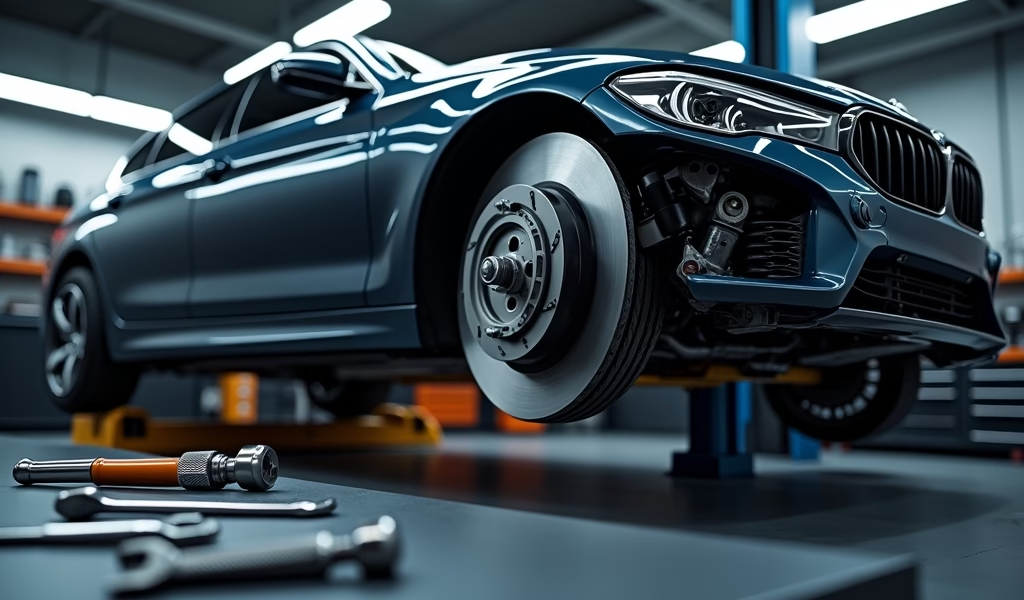Overview
The article explains how the Anti-lock Braking System (ABS) prevents wheel lockup during emergency braking, allowing drivers to maintain steering control while achieving optimal stopping distances. It details the system’s components, operation mechanics, warning signs of malfunction, and five essential maintenance practices including regular inspections, proper fluid maintenance, sensor cleaning, diagnostic scanning, and general brake care.
Table of Contents
- Understanding ABS in Cars: Your Safety Guardian
- How ABS Works: The Mechanics Behind the Magic
- The Life-Saving Benefits of ABS
- Warning Signs Your ABS Needs Attention
- 5 Essential ABS Maintenance Tips
- Conclusion: Keeping Your Safety Net Strong
- Frequently Asked Questions
Understanding ABS in Cars: Your Safety Guardian
When a deer darts across the road on a rainy night and you slam on the brakes, what prevents your car from skidding uncontrollably? That’s your Anti-lock Braking System (ABS) working its magic. As a mechanic with 15 years under the hood, I’ve seen how this technology has revolutionized vehicle safety, yet many drivers don’t fully understand what is ABS in cars until something goes wrong.
Think of ABS as your personal brake assistant, ready to step in during those heart-stopping moments when emergency braking becomes necessary. Unlike older vehicles where hard braking could lock your wheels and send you sliding, modern ABS prevents wheel lockup, helping you maintain steering control when you need it most.
ABS has come a long way since its introduction. Originally developed for aircraft in the 1920s and later adapted for racing cars, this technology has evolved into a standard safety feature in virtually every modern vehicle. By the 1990s, what was once a luxury had become increasingly common, and since 2013, ABS has been mandatory in all new passenger vehicles sold in the United States.
How ABS Works: The Mechanics Behind the Magic

Your ABS isn’t a single component but rather an integrated system of sensors, valves, and a control module working together to prevent wheel lockup during emergency braking. Let me break down the nuts and bolts of this engineering marvel:
The Key Components
The system consists of four main parts working in harmony:
- Speed sensors at each wheel that monitor rotation rates
- Hydraulic valves that can modulate brake pressure
- An ABS pump that restores pressure during the ABS cycle
- An electronic control unit (the system’s brain) that analyzes sensor data
ABS in Action: Split-Second Decision Making
When you hit the brakes hard, the ABS control module is analyzing wheel speed data up to 15 times per second. If it detects a wheel about to lock up (when a wheel stops rotating while the vehicle is still moving), it springs into action.
The module commands the hydraulic control unit to momentarily reduce brake pressure to that specific wheel, allowing it to regain traction. This cycle happens so rapidly that you feel it as a pulsation in the brake pedal – that vibrating sensation is actually your ABS working correctly!
This rapid modulation of brake pressure – applying and releasing in milliseconds – allows the wheels to continue rotating even during hard braking. The result? You maintain steering control and achieve the shortest possible stopping distance for the conditions.
Most drivers don’t realize that your car’s brake system is constantly making thousands of calculations during emergency stops. The system is essentially performing the same technique that professional drivers use called “threshold braking,” but with computer precision and at superhuman speed.
The Life-Saving Benefits of ABS
Having worked on thousands of vehicles throughout my career, I’ve seen the real-world impact of ABS. According to the National Highway Traffic Safety Administration, vehicles equipped with ABS are involved in fewer fatal crashes. Here’s why this technology matters:
- Maintains steering control during emergency braking, allowing you to steer around obstacles
- Reduces stopping distances on slippery surfaces like wet roads, snow, or ice
- Prevents tire flat-spotting, which can damage expensive tires during panic stops
- Decreases insurance premiums, as many companies offer discounts for ABS-equipped vehicles
- Builds driver confidence, especially for those less experienced in emergency situations
The beauty of ABS is that it works silently in the background until that rare moment when you truly need it. Many of my customers have shared stories of near-misses where their ABS helped them avoid what could have been serious accidents.
How to Tell if Your Car Has ABS
Nearly all modern vehicles have ABS, but here’s how to confirm yours does:
- Check for an amber ABS indicator light on your dashboard that briefly illuminates during startup
- Look for “ABS” printed on your brake pedal or nearby
- Consult your owner’s manual specifications
- Listen for a brief mechanical hum during startup – that’s the ABS self-test
Warning Signs Your ABS Needs Attention
Like any complex system, ABS can develop issues over time. Being attentive to these warning signs can help you address problems before they compromise your safety:
1. Illuminated Warning Lights
The most obvious indicator is a lit ABS warning light on your dashboard. This amber symbol typically shows “ABS” inside a circle or parentheses and should only briefly illuminate during startup. If it stays lit while driving, your ABS needs professional diagnosis immediately.
Sometimes both the ABS and brake warning lights illuminate together, which is particularly concerning as it may indicate a problem affecting both systems. Don’t ignore these dashboard messengers – they’re your first line of defense.
2. Unusual Brake Pedal Behavior
While pedal pulsation during hard braking is normal ABS operation, unexpected pulsation during routine stops signals trouble. You might notice your brake pedal suddenly becoming hard to press or, conversely, feeling spongy and soft.
These pedal personality changes often indicate air in the brake lines, fluid leaks, or issues with the ABS hydraulic unit. Any significant change in pedal feel warrants a proper brake inspection by a qualified technician.
3. Strange Noises
Your ABS will occasionally make noise during normal operation, but certain sounds should raise red flags:
- Grinding sounds when braking
- Clicking or buzzing from the wheel wells
- A constant humming from the engine compartment
- Unusual whirring when accelerating or decelerating
These sounds often indicate issues with ABS sensors, the pump motor, or related components. Don’t turn up the radio to drown them out – these noises are your vehicle communicating that something’s wrong.
4. Compromised Braking Performance
Perhaps the most concerning sign is when your vehicle simply doesn’t stop as efficiently as before. You might notice increased stopping distances or the vehicle pulling to one side during braking.
This performance degradation can happen gradually, making it easy to miss until you find yourself in an emergency situation. That’s why regular brake maintenance checks are so important – they catch these issues before they become dangerous.
5 Essential ABS Maintenance Tips

After decades of working on ABS systems, I’ve developed these five critical maintenance practices that will help keep your ABS performing optimally:
1. Schedule Regular System Inspections
Just like you wouldn’t skip your annual physical, your ABS needs regular checkups to catch small issues before they become major problems.
Best Practice: Have your ABS inspected annually, ideally during routine brake service. Many shops include basic ABS checks during standard service appointments, but be sure to specifically request it.
During these inspections, a good technician will:
- Visually inspect components for damage or corrosion
- Check electrical connections and wiring
- Examine brake lines for leaks or damage
- Test sensor operation and readouts
This preventive approach can save you from costly repairs down the road and ensure your safety system remains ready when needed.
2. Maintain Proper Brake Fluid Levels and Quality
Brake fluid is literally the lifeblood of your entire braking system, including ABS. This special hydraulic fluid transfers the force from your foot to the brake calipers, but it has a limited service life.
Best Practice: Check brake fluid levels monthly and have the fluid completely replaced every 2-3 years, regardless of mileage.
What many drivers don’t realize is that brake fluid is hygroscopic – it absorbs moisture from the air over time. This moisture lowers the fluid’s boiling point and introduces corrosion into your braking system. Fresh fluid appears clear to light amber, while aged fluid darkens to brown and may contain visible particles.
According to automotive experts at Edmunds, contaminated brake fluid is a leading cause of ABS system failures, often requiring expensive component replacement.
3. Keep ABS Sensors Clean and Protected
The wheel speed sensors are like the eyes of your ABS, constantly monitoring rotation rates and sending crucial data to the control module. These sensors are typically located at each wheel, exposed to road grime, salt, and debris.
Best Practice: Have speed sensors inspected and cleaned seasonally, especially after winter in regions where road salt is used.
When sensors become coated with debris or damaged, they can’t accurately measure wheel speed, compromising the entire ABS operation. A professional cleaning ensures these critical components continue to function properly, preventing false ABS activation or system failures.
4. Invest in Regular Diagnostic Scanning
Modern ABS systems are smart enough to detect and record problems before they become noticeable to drivers. Professional diagnostic scanning can reveal these hidden issues before they escalate.
Best Practice: Have your vehicle’s computer systems scanned for diagnostic trouble codes at least annually, and immediately if the ABS light illuminates.
Many minor ABS issues start with intermittent electrical problems that won’t trigger constant warning lights but are recorded in the system memory. Regular scanning can identify these problems early, often resulting in simpler, less expensive repairs.
5. Don’t Neglect General Brake Maintenance
Your ABS works in partnership with your conventional braking system. If basic brake components are worn or damaged, even the most sophisticated ABS can’t compensate.
Best Practice: Follow manufacturer-recommended maintenance schedules for all brake components and address issues promptly.
Key maintenance areas include:
- Brake pads: Replace when they reach 3-4mm thickness
- Rotors: Have them measured during pad replacement to ensure they meet minimum thickness specifications
- Calipers: Ensure they move freely and seals aren’t leaking fluid
- Brake lines: Inspect for cracks, corrosion, or damage that could compromise system pressure
Remember that ABS is an enhancement to your standard braking system, not a replacement for it. Good brake maintenance practices benefit both systems and ensure optimal stopping power when you need it most.
Conclusion: Keeping Your Safety Net Strong
Your car’s ABS is like a vigilant guardian, standing ready to intervene in those critical moments when a split second can make all the difference. By understanding what is ABS in cars and committing to its proper maintenance, you’re investing not just in your vehicle, but in your safety and the safety of everyone who travels with you.
The maintenance tips I’ve shared aren’t just mechanical recommendations—they represent years of hands-on experience seeing both well-maintained systems save lives and neglected ones fail at crucial moments. Regular inspections, fluid maintenance, sensor cleaning, diagnostic scanning, and general brake care form a comprehensive approach to ABS health.
Remember, your ABS doesn’t require constant attention, but it does deserve regular care. By incorporating these maintenance practices into your vehicle care routine, you ensure this sophisticated safety system remains ready to perform its life-saving function whenever called upon.
The next time you feel that familiar pedal pulsation during a sudden stop, you’ll know it’s not just your ABS working—it’s your commitment to proper maintenance paying off when it matters most.
Frequently Asked Questions
What does ABS stand for in cars?
ABS stands for Anti-lock Braking System. It’s a safety feature that prevents wheel lockup during hard braking.
Can I drive with the ABS light on?
While technically possible, driving with the ABS light on means your anti-lock braking system is disabled. Have it checked immediately, as your vehicle will be less safe in emergency braking situations.
How often should ABS be serviced?
The ABS system should be inspected annually during routine brake maintenance. Brake fluid, which affects ABS operation, should be replaced every 2-3 years.
Does ABS make your car stop faster?
On slippery surfaces like wet roads or snow, ABS typically reduces stopping distances. On dry pavement, a skilled driver might stop slightly faster without ABS, but most drivers achieve shorter stops with ABS.
How do I know if my ABS is working properly?
During normal driving, your ABS works silently in the background. You’ll only feel it activate (as pedal pulsation) during emergency braking, and the absence of a warning light indicates proper function.
HTML

